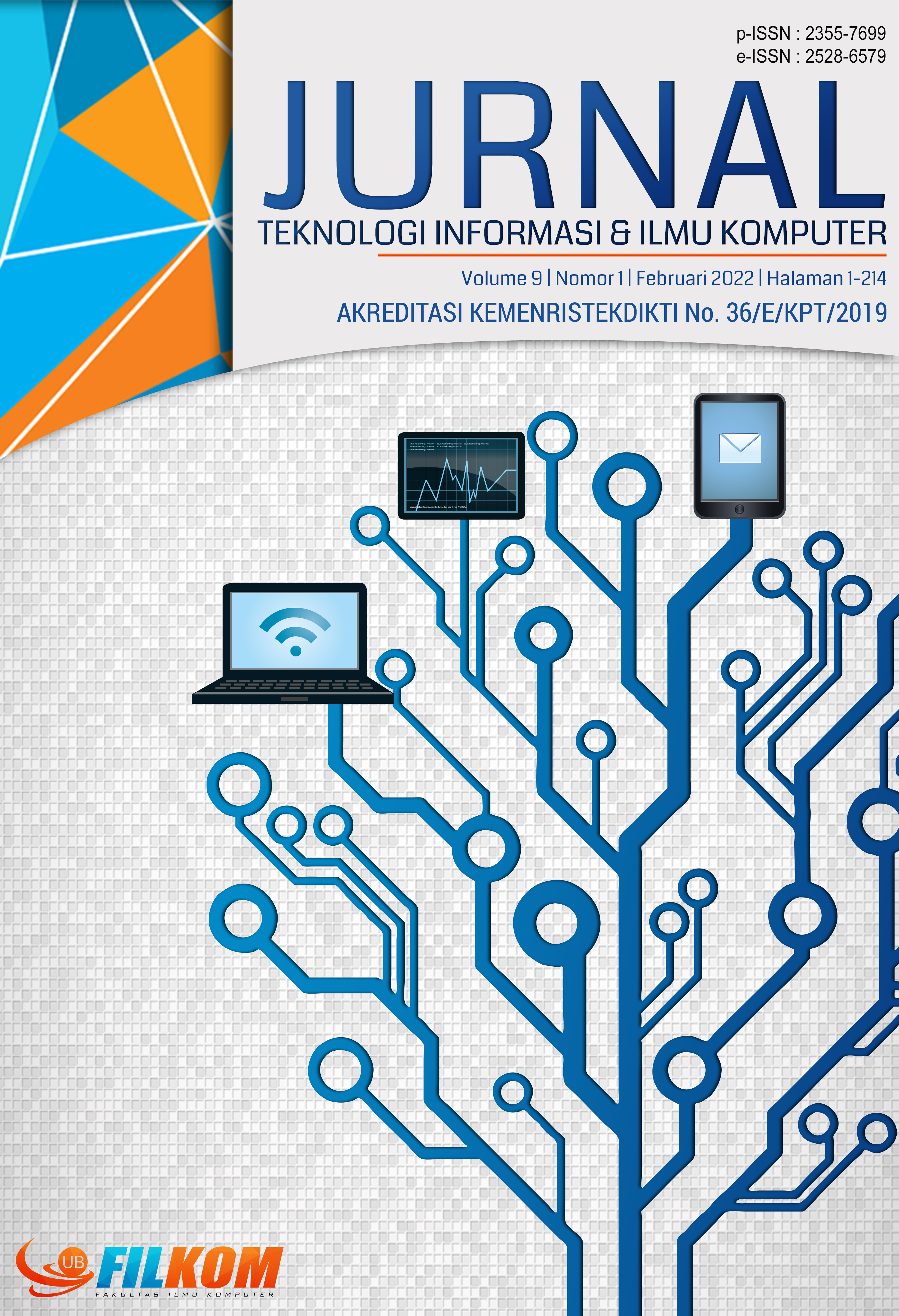Analisis Kemiskinan Digital Indonesia di Era Revolusi Industri 4.0
DOI:
https://doi.org/10.25126/jtiik.2022915021Abstrak
Salah satu tujuan Sustainable Development Goals (SDG’s) 2030 adalah pengentasan kemiskinan, penguatan hak-hak dasar masyarakat dan disrupsi sosial akibat revolusi industri 4.0. Namun di Indonesia masih terdapat individu dengan sedikit atau tanpa akses ke teknologi, inilah yang kemudian disebut sebagai kemiskinan digital. Oleh karena itu sangat penting bagi pemerintah untuk memetakan serta menganalisis kelompok yang terkena dampak inklusi digital. Untuk itulah maka penelitian ini dilakukan. Penelitian ini terdiri dari dua bagian, yaitu memetakan kemiskinan digital menggunakan QGIS kemudian membandingkan kemiskinan digital dengan kemiskinan ekonomi ke dalam empat kuadran. Data yang digunakan bersumber dari data Survei Sosial Ekonomi Nasional (Susenas) tahun 2019 dan 2020. Penggolongan kemiskinan digital dalam penelitian ini diadopsi dari model Barrantes. Hasil penelitian menunjukkan kemiskinan digital di Indonesia secara umum menurun. Kemudahan internet akses dan distribusi infrastruktur yang lebih baik bisa menjadi penyebab turunnya hal tersebut. Provinsi yang kondisi digitalnya lebih baik dalam rentang waktu 2019-2020 tersebut adalah Nusa Tenggara Timur (NTT) dan Aceh. Sedangkan provinsi yang indeks kemiskinan digitalnya tetap tinggi di tahun 2020 adalah Papua dan Papua Barat.
Abstract
One of the Sustainable Development Goals (SDGs) 2030 is poverty alleviation, strengthening people’s basic rights and social disruption due to industrial revolution 4.0. However, there are still individuals in Indonesia with little or no access to technology, which this term is then so-called digital poverty. It is therefore very important for the government to do mapping and analyzing groups affected by digital inclusion. For that reason this study is then conducted. This research consists of two parts, firstly is mapping digital poverty using QGIS and secondly is comparing digital poverty with economic poverty into four quadrants. The data used in this study is obtained from the 2019 and 2020 National Socio-Economic Survey (Susenas) data. The digital poverty classification in this study is adopted from Barrantes. The results show that digital poverty in Indonesia is generally decreasing. The ease of internet access and better distribution of infrastructure could be the causes of this decline. Provinces that are getting much better in digital condition within the periode of 2019-2020 are East Nusa Tenggara (NTT) and Aceh. Meanwhile, the provinces which the digital poverty index remain high in 2020 are Papua and West Papua.
Downloads
Referensi
(ITU), I. T. U. 2015. Measuring International Society Report.
ARIFIN, M. H. 2017. Internet, Ketimpangan Digital dan Kebijakan Inklusif. 3–15.
BAGCHI, K. 2005. Factors contributing to global digital divide: Some empirical results. Journal of Global Information Technology Management, 8(3), 47–65.
https://doi.org/10.1080/1097198X.2005.10856402
BARRANTES, R. 2007. Analysis of ICT Demand: What Is Digital Poverty and How to Measure It? DIGITAL POVERTY: Latin American and Caribbean Perspectives Edited, 29–53.
https://doi.org/10.3362/9781780441115.007
BPS. 2020a. BRS-Indeks Pembangunan Manusia (IPM) 2020. https://www.bps.go.id/pressrelease/2020/12/15/1758/
BPS. 2020b. BRS-Indeks Pembangunan Teknologi Informasi dan Komunikasi (IP-TIK) 2019. 95, 1–8.
BPS. 2021. BRS-Profil Kemiskinan di Indonesia September 2020. 16, 1–12.
CHAVULA, H. K. 2013. Telecommunications development and economic growth in Africa. Information Technology for Development, 19(1), 5–23.
https://doi.org/10.1080/02681102.2012.694794
CHINN, M. D., & FAIRLIE, R. W. 2007. The determinants of the global digital divide: A cross-country analysis of computer and internet penetration. Oxford Economic Papers, 59(1), 16–44. https://doi.org/10.1093/oep/gpl024
DONOU-ADONSOU, F., LIM, S., & MATHEY, S. A. 2016. Technological Progress and Economic Growth in Sub-Saharan Africa: Evidence from Telecommunications Infrastructure. International Advances in Economic Research, 22(1), 65–75. https://doi.org/10.1007/s11294-015-9559-3
FUADY, A. H. 2018. Teknologi Digital dan Ketimpangan Ekonomi di Indonesia. Masyarakat Indonesia Majalah Ilmu-Ilmu Sosial Indonesia, 4(1), 75-.
KEMENKOMINFO. 2019. No Title. https://kominfo.go.id/
KUZNETS, S. 1955. Economic Grwoth and Income Inequality. American Economic Review, March.
PERMATASARI, D. A., SUGIHARTI, L., & FUDHOLI, A. 2019. Digital Poverty Conditionsfor East Java in Fourth Industrial Revolution. International Journal of Recent Technology and Engineering, 8(4), 12450–12456. https://doi.org/10.35940/ijrte.d9249.118419
RAVALLION, M. 1998. Poverty Lines in Theory and Practice. The Intemnational Bank for Reconstruction and Development/THE WORLD BANK.
SAPUTRA, A. 2019. Survei Penggunaan Media Sosial Di Kalangan Mahasiswa Kota Padang Menggunakan Teori Uses and Gratifications. 40(2), 207. https://doi.org/10.14203/j.baca.v40i2.476
SOLOW, R. M. . 2010. A Contribution to the Theory of Economic Growth Author ( s ): Robert M . Solow Source : The Quarterly Journal of Economics , Vol . 70 , No . 1 ( Feb ., 1956 ), pp . 65-94 Published by : The MIT Press Stable URL : http://www.jstor.org/stable/1884513. The Quarterly Journal of Economics, 70(1), 65–94.
SUSANTO, A. 2016. Analisis Kondisi Digital Poverty di Indonesia. Jurnal Penelitian Pos Dan Informatika, 6(2), 169. https://doi.org/10.17933/jppi.2016.060204
SUSENO, A., & AGUS, R. T. 2012. Penggunaan Quantum GIS Dalam Sistem Informasi Geografis.
WORLD ECONOMIC FORUM. 2012. The Global Information Technology Report 2012 Living in a Hyperconnected World. In Forum American Bar Association.
Unduhan
Diterbitkan
Terbitan
Bagian
Lisensi

Artikel ini berlisensi Creative Common Attribution-ShareAlike 4.0 International (CC BY-SA 4.0)
Penulis yang menerbitkan di jurnal ini menyetujui ketentuan berikut:
- Penulis menyimpan hak cipta dan memberikan jurnal hak penerbitan pertama naskah secara simultan dengan lisensi di bawah Creative Common Attribution-ShareAlike 4.0 International (CC BY-SA 4.0) yang mengizinkan orang lain untuk berbagi pekerjaan dengan sebuah pernyataan kepenulisan pekerjaan dan penerbitan awal di jurnal ini.
- Penulis bisa memasukkan ke dalam penyusunan kontraktual tambahan terpisah untuk distribusi non ekslusif versi kaya terbitan jurnal (contoh: mempostingnya ke repositori institusional atau menerbitkannya dalam sebuah buku), dengan pengakuan penerbitan awalnya di jurnal ini.
- Penulis diizinkan dan didorong untuk mem-posting karya mereka online (contoh: di repositori institusional atau di website mereka) sebelum dan selama proses penyerahan, karena dapat mengarahkan ke pertukaran produktif, seperti halnya sitiran yang lebih awal dan lebih hebat dari karya yang diterbitkan. (Lihat Efek Akses Terbuka).












